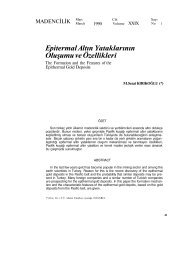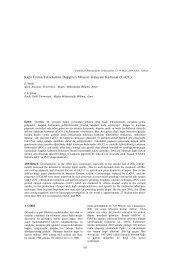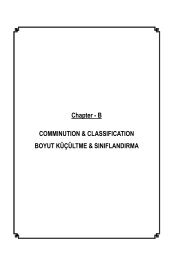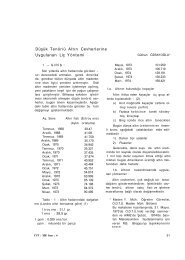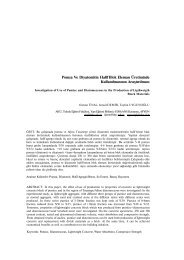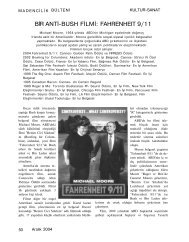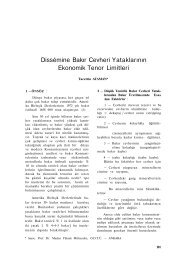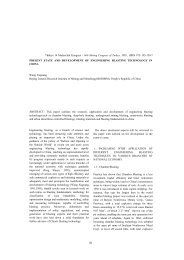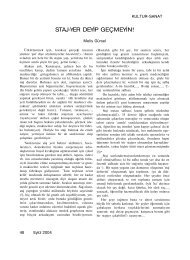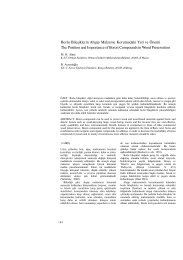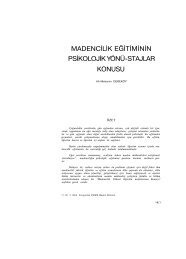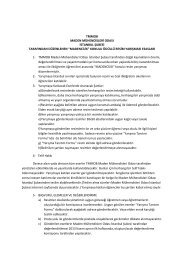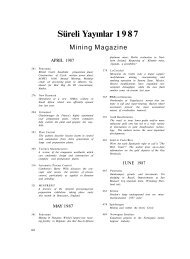A OPEN PIT MINING AÇIK OCAK MADENCİLİĞİ
A OPEN PIT MINING AÇIK OCAK MADENCİLİĞİ
A OPEN PIT MINING AÇIK OCAK MADENCİLİĞİ
You also want an ePaper? Increase the reach of your titles
YUMPU automatically turns print PDFs into web optimized ePapers that Google loves.
limestone and some other industrial minerals,<br />
this formula cannot be applied to evaluate<br />
the economic value of blocks. The reasons is<br />
that, the aim of mining the latter group of<br />
minerals (i.e. iron ore, coal, limestone), is to<br />
achieve a predetermined quality, and the<br />
price obtained for blended ore is constant<br />
and it does not depend on the quality of each<br />
individual block. In fact, there are various<br />
blocks with different qualities and ore-types<br />
which must be blended to produce a<br />
marketable product with regard to<br />
consumer’s targets. Ore-types are assigned<br />
on the basis of ore grade and contaminants.<br />
The solution to the problem of how to<br />
generate an optimal pit which contains an<br />
optimal mix of ores blocks is a combined<br />
operation of pit and blend optimizing. The<br />
aim of combined pit and blend optimizing is<br />
to produce a pit which yields different oretypes<br />
in such quantities that the sum of the<br />
profits of mining and blending operation is<br />
maximized.<br />
Mol and Gillies (1984) take the<br />
advantages of grade-tonnage curve to<br />
determine a cut-off grade in iron ore<br />
deposits, in accordance with the blend<br />
requirements. The main drawback of the<br />
approach is that it does not optimize the pit<br />
design. This technique may also lead to<br />
abandoning of some low grade blocks with<br />
low impurities, which might be included in<br />
the blended product.<br />
Srinivasan and Whittle (1996) developed a<br />
heuristic method to combine pit and blend<br />
optimization. Their method iteratively<br />
changes the price of each ore type until the<br />
quality of ore types mined is equal to the<br />
blending requirements.<br />
Osanloo and Rahmanpour (2012)<br />
developed an approach based on a<br />
combination of Binary integer programming<br />
(BIP) and network flow. In this method,<br />
those blocks that meet the blending<br />
requirements are selected using BIP. Then<br />
applying maximum flow technique, the final<br />
pit limit of the mine considering blending<br />
options is determined. This approach<br />
iteratively uses BIP to select the ore blocks<br />
that meet the blending requirements, which<br />
is quite time consuming. Therefore, there is a<br />
need for some fast algorithms in order to<br />
optimize the blending and pit design. This<br />
will enable the planner to compare any<br />
blending options to select the most suitable<br />
and profitable case.<br />
Section 2, briefly reviews the available<br />
methods for open pit design. Section 3,<br />
provides a general mathematical model for<br />
blend optimization. In section 4, the<br />
combined approach introduced by Osanloo<br />
and Rahmanpour (2012) will be described.<br />
Then a self-adapting differential evolutionary<br />
algorithm is developed for blend<br />
optimization. The proposed algorithm is<br />
applied to determine the final pit limit for<br />
Gol-E-Gohar iron ore mine which is<br />
discussed in section 5. Section 6 gives the<br />
final remarks of the paper.<br />
2 <strong>PIT</strong> OPTIMIZATION<br />
The aim of pit optimizing is to designs a pit<br />
in which (1) pit slope constraints are obeyed,<br />
and (2) total value (profit) of the pit is<br />
maximized. Pit value is the summation of<br />
those block-values that are included in the<br />
final pit. BEVs are normally calculated via<br />
equation 1. After the calculation of BEVs<br />
and developing an economic block model,<br />
the ultimate pit limit of the mine can be<br />
determined. Various techniques are available<br />
to determine the ultimate pit limit. When the<br />
ultimate pit limit is determined it means that<br />
the value of ore blocks (income) can pay the<br />
costs of removing the overlaying waste block<br />
(costs). Inside the pit limit, mining<br />
operations is economic with the highest<br />
profit, and outside the pit limit, open pit<br />
mining is not likely to be profitable.<br />
Optimum pit design methods are divided<br />
into Heuristic and Rigorous methods (Kim,<br />
1979). Heuristics are short cuts to solve the<br />
ultimate pit limits problem and heuristics<br />
such as moving cone technique are not likely<br />
to determine the optimum solution of the<br />
ultimate pit limit problem. On the other<br />
hand, these methods are easy to implement<br />
but it should be noted that they lack the<br />
rigorous mathematical proof. Pana (1965)<br />
introduced the moving (floating) cone<br />
technique. This technique creates a cone for<br />
120



